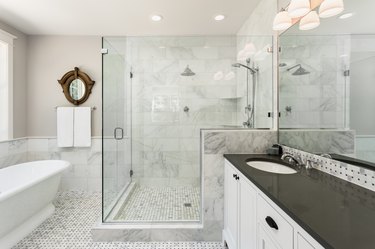Because of moisture, bathrooms are some of the primary areas of your home at risk of mold and mildew development. It is important to make sure that a proper vapor barrier (or vapor retarder) is installed on the walls in your bathroom whenever you're building or remodeling. You don't need to put a vapor barrier in the ceiling of the bathroom. If you already have water damage in an existing bathroom or you're uncomfortable installing a proper moisture barrier, you should call a professional.

Video of the Day
What Is a Vapor Barrier?
A vapor or moisture barrier is a layer of protection that is designed to act as a waterproof shield, helping to keep condensation away from wood, insulation and other mold-prone materials that are located behind the drywall. It's usually a thin layer of plastic that sits between the drywall and the studs. Plastic sheeting is used because of its low level of water permeability. It's also a relatively easy option for DIYers. Install vapor barriers after the bathroom's plumbing, electrical and insulation are complete.
Video of the Day
Liquid barriers may also be used to prevent moisture from getting into the walls. They are painted on surfaces and form a waterproof seal over drywall.
Using Plastic
Purchase a roll of 6 millimeter polyurethane, choosing a size that will have the fewest seams. This is important, because you don't want to give moisture any extra places to sneak through. You'll want to overlap any seams by 3 inches. You should also use tuck tape to connect the two edges. Other tapes, such as duct tape, shouldn't be used, as they are too porous.
Attach the plastic sheets directly to the studs using a hammer-tacker. A hammer-tacker is a small, easy-to-use tool that is swung like a hammer to apply staples. Pull the plastic tight before attaching, carefully stapling into the studs every 12 to 18 inches. Because you'll be stapling into a stud, the holes created by the staples will not cause an issue. If any of the holes are larger than the staples, you can cover the holes using tape that is meant specifically for waterproofing and moisture barriers. If the plastic becomes punctured, you should completely replace the sheet.
Using a Liquid Barrier
Using a liquid vapor barrier is also fairly easy for the average DIYer. These products are simply "painted" on walls and floors on top of drywall or cement board instead of putting up a plastic vapor barrier behind the drywall. This is ideal for homeowners who are replacing tile and are unsure whether or not there's a proper vapor barrier behind the existing drywall.
The downside to using a liquid product is that it can take a couple of hours to completely dry. Also, it should be the right thickness, which varies depending on the brand that you choose. Many people prefer this method, as it is easier to paint around items like pipes and electrical boxes.
Using a Waterproofing Membrane
A third option to protect your bathroom from condensation and help prevent mold growth is using a waterproofing membrane, which is usually sold in rolls. This type of moisture barrier can be made of plastic, rubber or coated-fabric materials. The sheets should be overlapped to prevent any seams. They are installed on top of cement backerboard, which is over the studs.
Once installed, tile can be applied directly on top. The downside to using a waterproofing membrane is that it's expensive. Additionally, the overlapped seams can cause some unevenness. However, they are necessary for any horizontal areas.
A Bathroom Fan Will Help
In addition to installing a vapor barrier, you should also consider installing a bathroom fan. This will help dry up any moisture in the bathroom, preventing mold from growing on other surfaces.